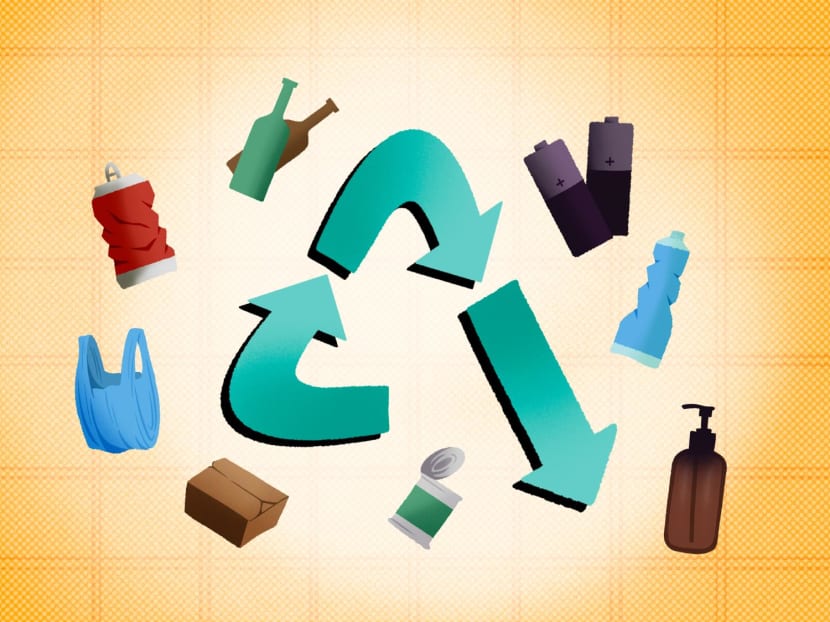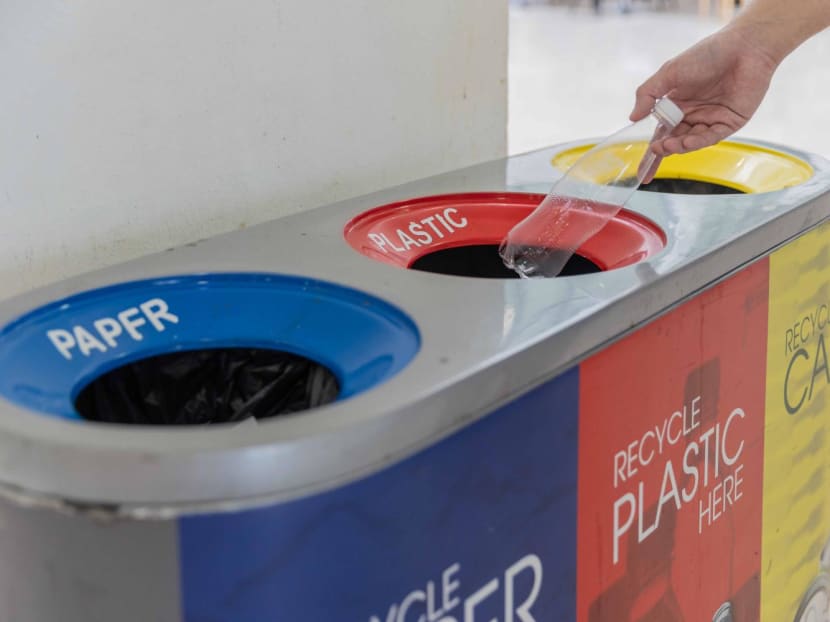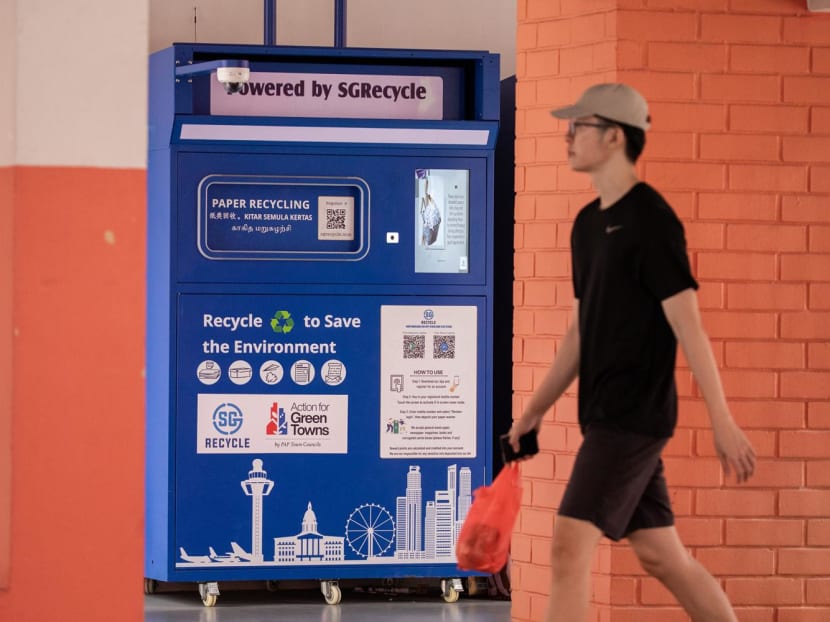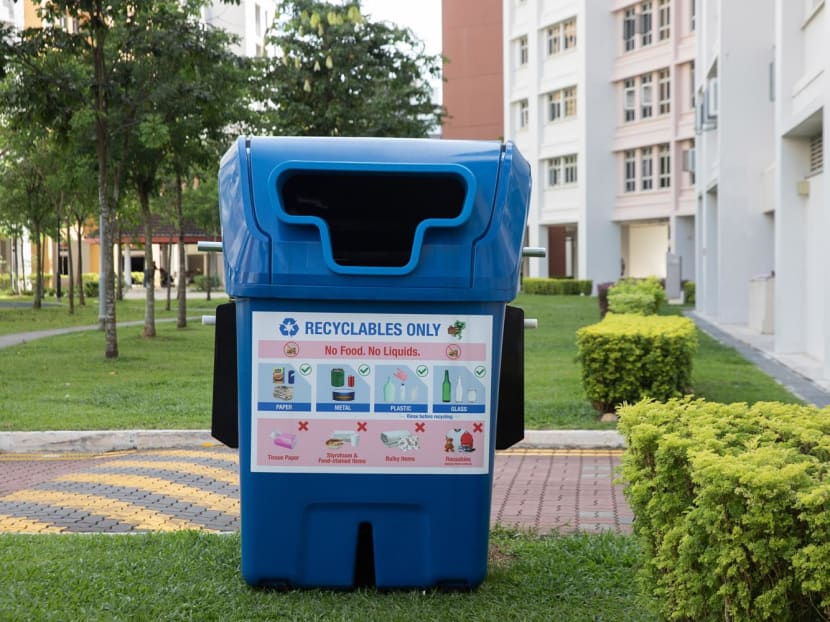The Big Read in short: Singapore's household recycling blues
SINGAPORE — Property agent Rose Tan throws her domestic waste in the designated blue recycling bins below her flat two to three times a day.

The recycling rate for domestic waste — from households and premises such as schools and hawker centres — in Singapore has fallen in the last five years.
- Although awareness about recycling has improved among Singaporeans amid a green push by the Government, Singapore’s domestic recycling rate has continued to fall in the last few years
- The Government and environmental experts have attributed the drop to a confluence of external and internal factors
- Recyclable waste exports have dropped following tightened regulations by waste-importing countries such as China while Covid-19 has driven up shipping costs as well as packaging waste
- Locally, despite greater awareness, there remains the persistent problem of contamination in blue recycling bins in housing estates
- While some efforts to segregate recyclable waste at the source will help to mitigate contamination, Singaporeans should ultimately aim to reduce their waste generated overall, said experts
Each week, TODAY’s long-running Big Read series delves into the trends and issues that matter. This week, we look at Singapore’s falling domestic recycling rate and how it can be boosted. This is a shortened version of the full feature, which can be found here.
SINGAPORE — Property agent Rose Tan throws her domestic waste in the designated blue recycling bins below her flat two to three times a day.
“Things like metal cans can be remade into something else, and they’re very useful for us. Why waste it?” said the 75-year-old.
Other residents in several housing estates whom TODAY spoke to last week also said that they make it a point to dispose of their waste materials in the blue bins below their flats for recycling.
They represent a growing number of Singaporeans who are aware of the virtues of recycling, widely regarded as a key solution to the ever-growing mountain of rubbish around the world.
Still, despite such awareness, the recycling rate for domestic waste — from households and premises such as schools and hawker centres — in Singapore has fallen in the last five years.
According to NEA statistics, the domestic recycling rate stood at 12 per cent last year, the lowest level in over a decade, and down from 22 per cent in 2018 and 13 per cent in 2021.
In response to TODAY’s queries, NEA said that the amount of paper and cardboard recycled has been lower since 2018 due to weaker demand from export markets and high freight costs.
Currently, all of Singapore’s paper and textile recyclables are exported for recycling.
E-commerce and online shopping has also led to an increase in paper and cardboard being disposed of, further reducing the recycling rate for these materials, said an NEA spokesperson.

WHY IT MATTERS
The drop in the domestic recycling rate over the years suggests that Singaporeans are recycling less, even as it aims to achieve its goal of being a zero-waste nation.
Under the Zero Waste Masterplan announced in 2019, Singapore has set a national recycling rate target of 70 per cent in 2030, and aims to reduce its daily rate of waste-to-landfill per capita by 30 per cent.
By 2030, the city state hopes to increase its domestic recycling rate to 30 per cent and its non-domestic recycling rate to 81 per cent.
Associate Professor Tong Yen Wah from the National University of Singapore’s College of Design and Engineering said that the drop in the domestic recycling rate is a concern because non-recycled waste goes to incinerators producing bottom ash.
The bottom ash goes to Pulau Semakau, Singapore’s only landfill, which will be full by 2035.
“This will affect the nation’s goal of achieving a zero-waste nation and also complicate our efforts to extend the life of Pulau Semakau,” said Assoc Prof Tong, who is from NUS’ College of Design and Engineering.
Addressing the falling domestic recycling rate in a social media post this week, Minister for Sustainability and the Environment Grace Fu said that it is worrying that Singaporeans are “using more, but recycling less”.
Food and plastic have the lowest recycling rates among the various waste streams, which is why the Government has taken steps such as making packaging reporting mandatory and requiring the segregation of food for special treatment, said Ms Fu.
“We must recognise that waste is everyone’s problem. As consumers, we have an important role to play in making sure these efforts are not futile.”
On its part, the Government has made a push for recycling in recent years, including strengthening local recycling capabilities and launching a campaign on how to reduce contamination of recyclable waste.
Its most recent initiative has been to distribute a Bloobox — a foldable and reusable box which can hold up to 5kg of recyclables — to households here for them to use.

THE BIG PICTURE
The drop in domestic recycling rate here coincides with external factors affecting the export of recyclable waste.
China, once the world’s largest importer of recyclable waste, banned the import of certain recyclable materials in 2018, including mixed paper and mixed plastics.
The ban, which followed several other regulations in the preceding years, was an attempt to curb the increasing amount of contaminated material that was clogging up the country’s material processing facilities.
Besides China, other countries such as Indonesia and Malaysia have also tightened their requirements for recycling waste imports. This has affected recyclable waste exports globally.
In Singapore, the amount of recyclable waste exported between 2015 and 2019 had also dropped steadily.
According to publicly available data, in 2015, 1,889,000 tonnes of recyclable waste were exported. This amounted to 41 per cent of Singapore’s total waste recycled that year.
In 2019, 1,439,000 tonnes of recyclable waste were exported, corresponding to 34 per cent of Singapore’s total waste recycled that year.
NEA had previously said that this waste was exported to countries including Australia, China, India, Indonesia, Malaysia, South Korea and Thailand for processing and recycling.
There is no publicly available data for subsequent years.
TODAY has asked the NEA and Ministry of Sustainability and the Environment (MSE) for updated figures on the amount of recyclable waste, including domestic waste, exported.
Besides international regulations on exports, shipping costs have also gone up due to the pandemic.
According to the Freightos Baltic Index, a global index that tracks the prices of shipping containers for goods transported by sea, the shipping container rate stood at US$8,236 on May 13, 2022 and has since dropped to US$1,440 as of May 12 this year.
The pandemic has also impacted recycling at a more downstream level, said experts.
Ms Jen Teo, executive director of the Singapore Environment Council, said that one reason for the drop in domestic recycling rate could be due to “revenge-shopping”, “revenge-dining-out” and “revenge-travelling” which has led to “a phenomenal rise” in trash production.
“The correct sorting and disposal of recyclable materials may become more difficult as a result of the increased waste creation,” said Ms Teo.
The rise in e-commerce during the pandemic also saw the emergence of sophisticated packaging and filling to ensure the safety of products as they were transported.
The mix of biodegradable and non-biodegradable materials in these packaging also led to complexities in recycling them, said Ms Teo.
THE BOTTOMLINE
Another issue that plagues recycling in Singapore is the contamination of recyclable trash — 40 per cent of what goes into the blue bins cannot be recycled. The contamination rate has hovered at 40 per cent since 2018.
For domestic recycling, Singapore uses a single-stream recyclables collection system where every residential block is given a blue recycling bin for residents to use. All recyclable trash is then thrown into the bin and sorted centrally.
The authorities have justified this single-stream, or commingling approach, as one that helps to improve the recycling rate as it is more convenient for residents to recycle without having to sort their recyclables by material type.
Stickers are currently placed on the blue bins, indicating to residents what can and cannot be thrown inside. However, residents still throw in contaminating items, such as food and liquids, thus undermining the efforts of those who have recycled correctly.
“Recyclables that are contaminated by food or liquids cannot be recycled which makes them no different from general waste,” said Zero Waste SG, an non-governmental group advocating for zero-waste in Singapore. Despite being intended for recycling, these contaminated trash would be disposed of, incinerated and landfilled.

As 2030 beckons, Singapore continues to grapple between the twin needs of improving the effectiveness of its recycling process and keeping it convenient for residents to recycle their domestic waste.
Following other countries’ models might also be another way to work around the structural limitations that Singapore has, such as the density and already pre-existing infrastructure that makes building a recycling chute in every block challenging.
For example, South Korea operates on a pay-as-you throw system, where residents have to buy trash bags for general waste, food waste, and recyclable materials, which are then disposed of separately.
Another suggestion is to increase the use of an automated segregation system of recyclable waste collected.
And while improved economic conditions globally could eventually help to boost Singapore’s recyclable waste exports, and consequently, recycling rate, the bigger change should start from reducing Singapore’s waste consumption.
Said Assoc Prof Tong: “We, both the authorities and the public, should do our best to minimise the waste that we generate, then we can overcome the limitations in the waste management system....(and) we will not be subjected to market forces or even have to recycle.













